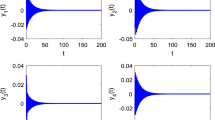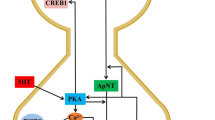Abstract
In this paper, the dynamics of single and two electrically coupled map-based neurons under external electrical stimulation is studied. In order to realize the synchronization of two chaotic spiking neurons, a controller based on the idea of feedback linearization is proposed. The simulation results demonstrate the effectiveness of this developed control method. An important feature of the feedback control is that the amplitude of control signal tends to zero as soon as the synchronization is achieved.
Similar content being viewed by others
References
M. I. Rabinovich, P. Varona, A. I. Selverston, and H. D. I. Abarbanel, “Dynamical principles of neuroscience,” Rev. Mod. Phys., vol. 78, pp. 1213–1265, 2006.
R. C. Elson, A. I. Selverston, R. Huerta, N. F. Rulkov, M. I. Rabinovich, and H. D. I. Abarbanel, “Synchronous behavior of two coupled biological neurons,” Phys. Rev. Lett., vol. 81, pp. 5692–5695, 1998.
A. K. Kryukov, V. S. Petrov, L. S. Averyanova, G. V. Osipov, W. Chen, O. Drugova, and C. K. Chan, “Synchronization phenomena in mixed media of passive, excitable, and oscillatory cells,” Chaos, vol. 18, 037129, 2008.
S. Boccaletti, J. Kurths, G. Osipov, D. L. Valladares, and C. S. Zhou, “The synchronization of chaotic systems,” Physics Reports, vol. 366, pp. 1–101, 2002.
C. M. Gray, P. König, A. K. Engel, and W. Singer, “Oscillatory responses in cat visual cortex exhibit inter-columnar synchronization which reflects global stimulus properties,” Nature, vol. 338, pp. 334–337, 1989.
R. Eckhorn, R. Bauer, W. Jordan, M. Brosch, W. Kruse, M. Munk, and H. J. Reitboeck, “Coherent oscillations: a mechanism of feature linking in the visual cortex? multiple electrode and correlation analyses in the cat,” Biol. Cybern., vol. 60, pp. 121–130, 1988.
W. Singer, “Synchronization of cortical activity and its putative role in information processing and learning,” Annu. Rev. Physiol., vol. 55, pp. 349–374, 1993.
W. A. MacKay, “Synchronized neuronal oscillations and their role in motor processes,” Trends Cogn. Sci., vol. 1, pp. 176–183, 1997.
H. J. Freund, “Motor unit and muscle activity in voluntary motor control,” Physiol Rev., vol. 63, pp. 387–436, 1983.
R. Levy, W. D. Hutchison, A. M. Lozano, and J. O. Dostrovsky, “High-frequency synchronization of neuronal activity in the subthalamic nucleus of Parkinsonian patients with limb tremor,” J. Neurosci., vol. 20, pp. 7766–7775, 2000.
M. La Rosa, M. I. Rabinovicha, R. Huerta, H. D. I. Abarbanel, and L. Fortuna, “Slow regularization through chaotic oscillation transfer in an unidirectional chain of Hindmarsh-Rose models,” Phys. Lett. A, vol. 266, pp. 88–93, 2000.
M. Dhamala, V. K. Jirsa, and M. Ding, “Enhancement of neural synchrony by time delay,” Phys. Rev. Lett. vol. 92, 074104, 2004.
J. Wang, B. Deng, and K. M. Tsang, “Chaotic synchronization of neurons coupled with gap junction under external electrical stimulation,” Chaos, Solitons and Fractals. vol. 22, pp. 469–476, 2004.
Q. Y. Wang, Q. S. Lu, G. R. Chen, and D. H. Guo, “Chaos synchronization of coupled neurons with gap junctions,” Phys. Lett. A, vol. 356, pp. 17–25, 2006.
R. C. Elson, A. I. Selverston, R. Huerta, N. F. Rulkov, M. I. Rabinovich, and H. D. I. Abarbanel, “Synchronous behavior of two coupled biological neurons,” Phys. Rev. Lett., vol. 81, pp. 5692–5695, 1999.
Y. Q. Che, J. Wang, S. S. Zhou, and B. Deng, “Robust synchronization control of coupled chaotic neurons under external electrical stimulation,” Chaos, Solitons and Fractals, vol. 40, pp. 1333–1342, 2009.
O. Cornejo-Pérezand and R. Femat, “Unidirectional synchronization of Hodgkin-Huxley neurons,” Chaos, Solitons and Fractals, vol. 25, pp. 43–53, 2005.
J. Wang, B. Deng, and X. Y. Fei, “Synchronizing two coupled chaotic neurons in external electrical stimulation using backstepping control,” Chaos, Solitons and Fractals, vol. 29, pp. 182–189, 2006.
J. Wang, B. Deng, and X. Y. Fei, “Chaotic synchronization of two coupled neurons via nonlinear control in external electrical stimulation,” Chaos, Solitons and Fractals, vol. 27, pp. 1272–1278, 2006.
C. A. S. Batista, S. R. Lopes, R. L. Viana, and A. M. Batista, “Delayed feedback control of bursting synchronization in a scale-free neuronal network,” Neural Networks, vol. 23, pp. 114–124, 2010.
O. V. Popovych, C. Hauptmann, and P. A. Tass, “Control of neuronal synchrony by nonlinear delayed feedback,” Biol. Cybern., vol. 95, pp. 69–85, 2006.
A. L. Hodgkin and A. F. Huxley, “A quantitative description of membrane current and its application to conduction and excitation in nerve,” J. Physiol., vol. 117, pp. 500–544, 1952.
R. FitzHugh, “Mathematical models of threshold phenomena in the nerve membrane,” Bull. Math. Biophysics, vol. 17, pp. 257–278, 1955.
R. M. Rose and J. L. Hindmarsh, “The assembly of ionic currents in a thalamic neuron I. the threedimensional model,” Proc. R. Soc. Lond. B, vol. 237, pp. 267–288, 1989.
N. F. Rulkov, “Regularization of synchronized chaotic bursts,” Phys. Rev. Lett., vol. 86, pp. 183–186 2001
N. F. Rulkov, “Modeling of spiking-bursting neural behavior using two-dimensional map,” Phys. Rev. E, vol. 65, 041922, 2002.
B. Ibarz, J. M. Casado, and M. A. F. Sanjuan, “Map-based models in neuronal dynamics,” Physics Reports, vol. 501, pp. 1–74, 2011.
N. F. Rulkov, I Timofeev, and M. Bazhenov, “Oscillations in large-scale cortical networks: mapbased model,” J. Comput. Neurosci., vol. 17, pp. 203–223, 2004.
M. Bazhenov, N. F. Rulkov, and I. Timofeev, “Effect of synaptic connectivity on long-range synchronization of fast cortical oscillations,” J. Neurophysiolgy, vol. 100, pp. 1562–1575, 2008.
X. Shi and Q. Lu, “Burst synchronization of electrically and chemically coupled map-based neurons,” Physica A, vol. 388, pp. 2410–2419, 2009.
H. Cao and M. A. F. Sanjuán, “A mechanism for elliptic-like bursting and synchronization of bursts in a map-based neuron network,” Cogn. Process., vol. 10, pp. 23–31, 2009.
B. Ibarz, H. Cao, and M. A. F. Sanjuán, “Bursting regimes in map-based neuron models coupled through fast threshold modulation,” Phys. Rev. E, vol. 77, 051918, 2008.
G. Tanaka, B. Ibarz, M. A. F. Sanjuán, and K. Aihara, “Synchronization and propagation of bursts in network of map neurons,” Chaos, vol. 16, 013113, 2006.
B. Ibarz, G. Tanaka, M. A. F. Sanjuán, and K. Aihara, “Sensitivity versus resonance in twodimensional spiking-bursting neuron models,” Phys. Rev. E, vol. 75, 041902, 2007.
M. A. Stuchly and T. W. Dawson, “Interaction of low-frequency electric and magnetic fields with the human body,” Proc. IEEE, vol. 88, pp. 643–664, 2000.
C. F. Blackman, S. G. Benane, D. J. Elliott, D. E. House, and M. M. Pollock, “Influence of electromagnetic fields on the efflux of calcium ions from brain tissue in vitro: a three-model analysis consistent with the frequency response up to 510 Hz,” Bioelectromagnetics, vol. 9, pp. 215–327, 1988.
T. Kotnik, D. Miklavčič, and T. Slivnik, “Time course of transmembrane voltage induced by timevarying electric fields-a method for theoretical analysis and its application,” Bioelectrochem. Bioenerg., vol. 45, pp. 3–16, 1998.
T. Kotnik and D. Miklavcic, “Theoretical evaluation of the distributed power dissipation in biological cells exposed to electric fields,” Bioelectromagnetics, 2000, vol. 21, pp. 385–394, 2000.
T. Zhang, J. Wang, X. Y. Fei, and B. Deng, “Synchronization of coupled FitzHugh-Nagumo systems via MIMO feedback linearization control,” Chaos, Solitons and Fractals, vol. 33, pp. 194–202, 2007.
C. C. Fuh and H. H. Tsai, “Control of discrete-time chaotic systems via feedback linearization,” Chaos, Solitons and Fractals, vol. 13, pp. 285–294, 2002.
K. Nam, “Linearization of discrete-time nonlinear systems and a canonical structure,” IEEE Trans Automatic Control, vol. 34, pp. 119–122, 1989.
B. Jakubczyk, “Feedback linearization of discretetime systems,” Systems and Control Letters, vol. 9, pp. 411–416, 1987.
Author information
Authors and Affiliations
Corresponding author
Additional information
Recommended by Editorial Board member Yoshito Ohta under the direction of Editor Jae Weon Choi. This work was supported by the Key National Natural Science Foundation of China Grant 50537030, the National Natural Science Foundation of China Grant 50707020, the Postdoctoral Science Foundation of China Grant 20070410756 and the Hong Kong Polytechnic University Grant G-U488.
Hai-Tao Yu received his B.S. degree from the Hebei University of Technology, Tianjin, China, and his M.S. degree from the Tianjin University, Tianjin, China. He is currently a Ph.D. candidate at the School of Electrical Engineering and Automation, Tianjin University, Tianjin, China. His current research interests include nonlinear control and neural control engineering.
Yiu Kwong Wong received his BSc and MSc degrees from the University of London, and his Ph.D. degree from the Heriot-Watt University, UK. His current research interests include modeling, simulation, nonlinear control and intelligent control.
Wai Lok Chan received his BSc(Eng) and MPhil degrees from University of Hong Kong, and his Ph.D. degree from City University London. He is now an Associate Professor in the Department of Electrical Engineering, The Hong Kong Polytechnic University. His major research interests are in microprocessor applications and applications of artificial intelligence.
Kai Ming Tsang received his B.Eng. and Ph.D. degrees in Control Engineering from the University of Sheffield, U.K. At present, he is an Associate Professor in the Department of Electrical Engineering of the Hong Kong Polytechnic University. His research interests include system identification, fuzzy logic, adaptive control and pattern recognition.
Jiang Wang received his B.S., M.S. and Ph.D. degrees from the Tianjin University, Tianjin, China. He is currently a Professor at the School of Electrical Engineering and Automation, Tianjin University, Tianjin, China. His current research interests include process control, nonlinear control and neural control engineering.
Rights and permissions
About this article
Cite this article
Yu, HT., Wong, Y.K., Chan, W.L. et al. Feedback linearization control of chaos synchronization in coupled map-based neurons under external electrical stimulation. Int. J. Control Autom. Syst. 9, 867–874 (2011). https://doi.org/10.1007/s12555-011-0507-6
Received:
Revised:
Accepted:
Published:
Issue Date:
DOI: https://doi.org/10.1007/s12555-011-0507-6




